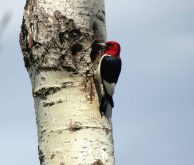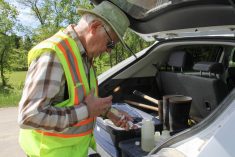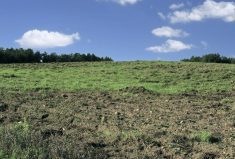As a child, Rick Andrews could see the future.
“I was one of those very fortunate people who knew what I wanted to do at a very young age,” he says. By the time Andrews was in his pre-teens, he had become enamoured with the outdoors and knew he wanted to work in conservation and the preservations of wild areas.
Andrews was recently honoured by Ducks Unlimited Canada (DUC) for his 43 years of service with the organization when it named a 160-acre stretch of marsh and grasslands north of Brandon in his honour.
Read Also

Pig shipments to U.S. slow as new COOL looms
A Manitoba pork marketer says some U.S. processors have shut their doors to Canadian pigs as enforcement of U.S. voluntary country of origin labelling (vCOOL) looms.
Andrews grew up in Winnipeg but came by his love of nature honestly.
“For family vacations, we’d get in the station wagon and go camping somewhere out of the city,” he says. “We travelled all across Manitoba, Minnesota and Ontario, and that’s where I had the opportunity to be exposed to wild areas. Always camping and always outdoors.”
[RELATED] The Conservation Trust pledges $2.86 million to conservation projects
When Andrews started university, there was no wildlife management program at the University of Manitoba. The closest he could get was zoology.
“I talked to as many professional biologists and professors to help me put together a program within the zoology department that would give me some background that I could eventually use in wildlife management.”
In May 1977, Andrews applied for a position at DUC after graduating from university with honours in zoology, but wasn’t the chosen candidate. However, a month later, DUC called to say its first choice hadn’t worked out and offered Andrews a position at provincial headquarters.
He would spend his entire career from 1977 to 2020 at the Brandon office, progressing from field biologist to manager of provincial operations.

Through the course of Andrews’ career, the scope of DUC activity went through many changes. A significant such change was development of the North American Waterfowl Management Plan, an international partnership between Canada, the United States and Mexico to study waterfowl migratory patterns and preserve wetland areas. The agreement opened fundraising opportunities that allowed the organization to expand its scope.
Conservation agreements became new tools for DUC.
“We fully recognized that, in southwest Manitoba at least, most of the habitat we needed to preserve is on private lands,” says Andrews. “So, we needed to find ways to work with the landowners and develop win-win programs that would not only benefit waterfowl and the environment but also landowners.”
The partnership between DUC and agricultural producers began to flourish.
“Ducks and cows need two things to survive: water and grass,” says Andrews. Thus it made sense to find programs that could benefit ranchers, cow-calf operations and feedlots.
Andrews says the relationship that has developed between agriculture and DUC is critical.
“Landowners have final say on what we do, when they sign a conservation easement with us, so in terms of relationship, it’s very important.”
The DUC winter wheat program, which was also developed during Andrews’ tenure, is another example of the relationship between the organization and agriculture. The program offers incentives to farmers for planting winter wheat for the first time.
[RELATED] Winter wheat is for the birds — and farmers
“Our winter wheat program is an interesting one,” says Andrews. “We became aware of these early-nesting ducks that, as soon as they come back in the spring and there’s any open water, they start nesting right away.” The pintail duck is one such species.
“They come back and there’s not much to nest in,” but since winter cereals are generally planted into standing stubble, there is short cover on those fields.
“These birds are a true prairie species so they’re used to short cover and they go, ‘hey, look at this, it’s greening up already. It’s somewhere I can nest.’”
Andrews was joined by nearly 50 family members, friends and former co-workers at the Sept. 29 dedication ceremony, which featured the unveiling of a bronze plaque near Rapid City, where he had restored native prairie grass in the 1990s.
















